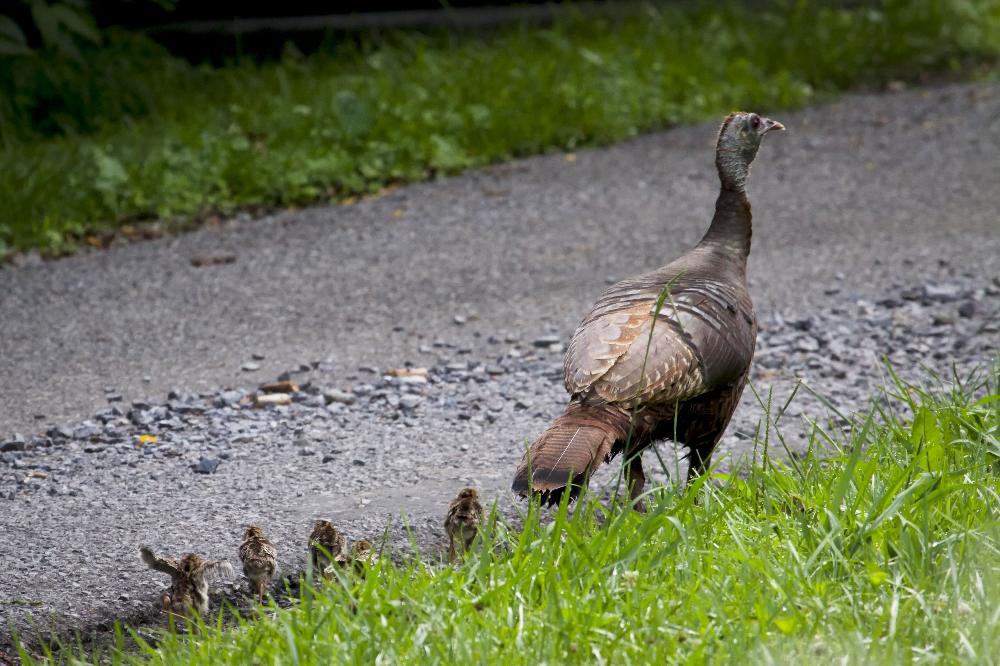Wild turkeys are quite common within their range, especially in areas where hunting is banned.
Despite its size, a wild turkey can fly fairly quickly, although its flight is usually of short duration. It prefers to spend its time on the ground, where it is a swift runner. The turkey is active during the daytime and will roost in trees at night. This is a social bird who spends most of its time in a flock. It is a prized game bird, and has been throughout its history. It almost became the national bird of the United States, losing to the Bald Eagle by one vote.
Species Description:
Length: 93.9 to 116.8 cm
Physical characteristics: This is a very large bird, with a fan-shaped tail, long, spurred legs (lacking in the female) and an unfeathered blue head and reddish throat. The breast, belly and back are a dark brown barred with black. The wings are an iridescent bronze and green. The male is larger than the female overall, and has a larger head and red wattles. A long tuft from the breast is more often seen on the males.
Voice: Call is a very loud series of gobbles.
Breeding habitat:
The Wild Turkey frequents mature deciduous or mixed forest with moderate understory, woodland openings (especially in the mountains) and agricultural areas. It will roost in the tall trees at night.
Mating system:
Polygynous, one male may mate with several females. One brood is raised in a season.
Nest:
The nest is a shallow depression in the soil lined with dead leaves, and located at the base of a tree, under a log or bush or in dense grass or vines. The female builds the nest.
Eggs:
Normally 10-12 eggs are laid, but the number can range from 6-20. The eggs are pale buff to white, and marked with dull brown dots. 63mm (2.5″).
Chick development:
The female incubates for 27-28 days. The chicks are precocial at hatching and can walk within one day. The female broods the young (called poults) at night for up to four weeks. The poults remain with the hen through the summer and into the fall, often joining with other family groups. The young males leave the mother in late fall, while the female poults stay on until the next spring.
Diet:
This species forages on the ground for acorns, nuts, seeds, fruits and plants. It will also eat insects (such as beetles, grasshoppers and caterpillars), salamanders, worms and snails. The food items are swallowed whole and then ground up in the bird?s gizzard.
Parasites:
The louse Chelopistes meleagridis Linnaeus (Philopteridae) was collected from a juvenile turkey in Cades Cove (Reeves et al. 2007).
Examinations of a fecal sample collected from wild turkey at Purchase Knob (C. Faulkner, V. Faulkner, and S. Stone; 2005) detected oocysts of an unidentified coccidian parasite, eggs of an unidentified intestinal nematode of the genus Capillaria (Trichuroidea), and possible eggs of an unidentified intestinal nematode of the genus Porrocaecum (Toxoocaridae).
Conservation Biology:
Wild Turkey populations dropped to a low point around the turn of the 20th century because of hunting and habitat loss. It has been successfully reintroduced to much of its former range, and has expanded its ancestral range into several western states. Proper management of habitat and hunting are the most important conservation issues.
Breeding: The Wild Turkey range extends from southern Canada south through the eastern United States and in fragmented areas in the West, and into central Mexico.
Winter: This species is non-migratory. Flocks of up to 40 to 50 birds may form in the winter.
The Wild Turkey is a fairly common year-round resident bird species in the Park. It is most common at low elevations in the park. A survey of breeding birds in the Park, performed from 1996-1999, ranked Wild Turkey as the 67th most abundant species out of 113 species observed during the breeding season. Estimates from this survey indicate that overall Wild Turkey density in the park during the breeding season is approximately 0.0013 pairs per hectare. More than 95% of the observations from this survey were made at elevations below 3,000 feet.
References:
Alsop, F. J. III. 1991. Birds Of The Smokies. Great Smoky Mountains History Association, Gatlinburg, Tennessee.
Bent, A. C. and Collaborators. 1996 - 2002. Wild Turkey, In Life Histories of Familiar North American Birds, ed., Patricia Query Newforth.
Committee on Classification and Nomenclature of the American Ornithologists' Union. 2002. Forty-third supplement to the American Ornithologists' Union Check-list of North American Birds. The Auk 119: 897-906.
Eaton, Stephen W. 1992. Wild Turkey. In The Birds of North America, No. 22 (A. Poole, P. Stettenheim, and F. Gill, Eds.). Philadelphia: The Academy of Natural Sciences; Washington, DC: The American Ornithologists? Union.
Ehrlich, P. R., D. S. Dobkin, and D. Wheye. 1988. The Birder's Handbook: a Field Guide to the Natural History of North American Birds. Simon and Schuster, Inc., New York.
Elphick, C., J. B. Dunning, Jr., and D. A. Sibley, eds. 2001. The Sibley Guide to Bird Life and Behavior. Alfred A. Knopf, New York.
Gough, G. A., Sauer, J. R., Iliff, M. Patuxent Bird Identification Infocenter. 1998. Version 97.1. Patuxent Wildlife Research Center, Laurel, MD. http://www.mbr-pwrc.usgs.gov/id/framlst/infocenter.html
Reeves, W. K., L. A. Durden, C. M. Ritzi, K. R. Beckham, P. E. Super, and B. M. O?Connor. 2007. Ectoparasites and other ectosymbiotic arthropods of vertebrates in the Great Smoky Mountains National Park, USA. Zootaxa.
Sibley, D. A. 2000. The Sibley Guide to Birds. Alfred A. Knopf, New York.
Stupka, A. 1963. Notes on the Birds of the Great Smoky Mountains National Park. University of Tennessee Press.
Animalia
Chordata
Aves
Galliformes
Phasianidae
Phenology
Linnaeus

